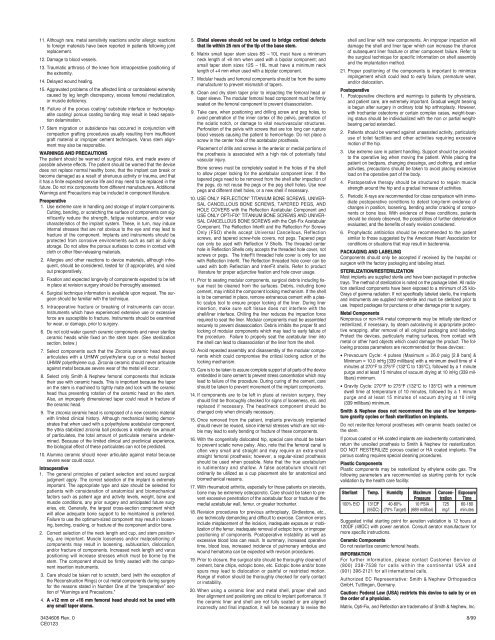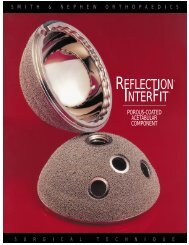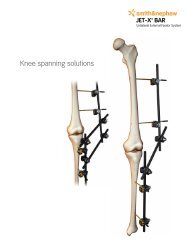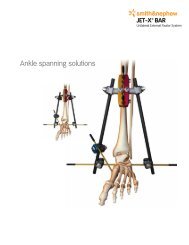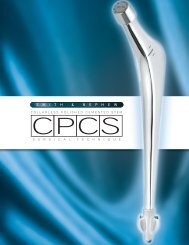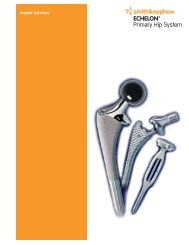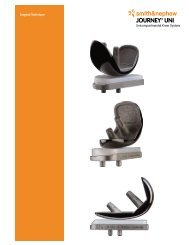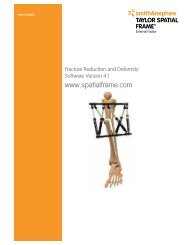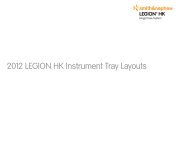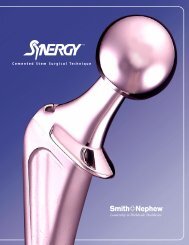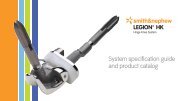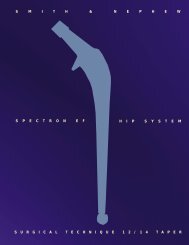REFLECTION® - DUROLANE
REFLECTION® - DUROLANE
REFLECTION® - DUROLANE
You also want an ePaper? Increase the reach of your titles
YUMPU automatically turns print PDFs into web optimized ePapers that Google loves.
11. Although rare, metal sensitivity reactions and/or allergic reactionsto foreign materials have been reported in patients following jointreplacement.12. Damage to blood vessels.13. Traumatic arthrosis of the knee from intraoperative positioning ofthe extremity.14. Delayed wound healing.15. Aggravated problems of the affected limb or contralateral extremitycaused by leg length discrepancy, excess femoral mediatization,or muscle deficiency.16. Failure of the porous coating/ substrate interface or hydroxylapatitecoating/ porous coating bonding may result in bead separationdelamination.17. Stem migration or subsidence has occurred in conjunction withcompaction grafting procedures usually resulting from insufficientgraft material or improper cement techniques. Varus stem alignmentmay also be responsible.WARNINGS AND PRECAUTIONSThe patient should be warned of surgical risks, and made aware ofpossible adverse effects. The patient should be warned that the devicedoes not replace normal healthy bone, that the implant can break orbecome damaged as a result of strenuous activity or trauma, and thatit has a finite expected service life and may need to be replaced in thefuture. Do not mix components from different manufacturers. AdditionalWarnings and Precautions may be included in component literature.Preoperative1. Use extreme care in handling and storage of implant components.Cutting, bending, or scratching the surface of components can significantlyreduce the strength, fatigue resistance, and/or wearcharacteristics of the implant system. These, in turn, may induceinternal stresses that are not obvious to the eye and may lead tofracture of the component. Implants and instruments should beprotected from corrosive environments such as salt air duringstorage. Do not allow the porous surfaces to come in contact withcloth or other fiber-releasing materials.2. Allergies and other reactions to device materials, although infrequent,should be considered, tested for (if appropriate), and ruledout preoperatively.3. Fixation and expected longevity of components expected to be leftin place at revision surgery should be thoroughly assessed.4. Surgical technique information is available upon request. The surgeonshould be familiar with the technique.5. Intraoperative fracture or breaking of instruments can occur.Instruments which have experienced extensive use or excessiveforce are susceptible to fracture. Instruments should be examinedfor wear, or damage, prior to surgery.6. Do not cold water quench ceramic components and never sterilizeceramic heads while fixed on the stem taper. (See sterilizationsection, below.)7. Select components such that the Zirconia ceramic head alwaysarticulates with a UHMW polyethylene cup or a metal backedUHMW polyethylene cup. Zirconia ceramic should never articulateagainst metal because severe wear of the metal will occur.8. Select only Smith & Nephew femoral components that indicatetheir use with ceramic heads. This is important because the taperon the stem is machined to tightly mate and lock with the ceramichead thus preventing rotation of the ceramic head on the stem.Also, an improperly dimensioned taper could result in fracture ofthe ceramic head.9. The zirconia ceramic head is composed of a new ceramic materialwith limited clinical history. Although mechanical testing demonstratesthat when used with a polyethylene acetabular component,the yttria stabilized zirconia ball produces a relatively low amountof particulates, the total amount of particulate remains undetermined.Because of the limited clinical and preclinical experience,the biological effect of these particulates can not be predicted.10. Alumina ceramic should never articulate against metal becausesevere wear could occur.Intraoperative1. The general principles of patient selection and sound surgicaljudgment apply. The correct selection of the implant is extremelyimportant. The appropriate type and size should be selected forpatients with consideration of anatomical and biomechanicalfactors such as patient age and activity levels, weight, bone andmuscle conditions, any prior surgery and anticipated future surgeries,etc. Generally, the largest cross-section component whichwill allow adequate bone support to be maintained is preferred.Failure to use the optimum-sized component may result in loosening,bending, cracking, or fracture of the component and/or bone.2. Correct selection of the neck length and cup, and stem positioning,are important. Muscle looseness and/or malpositioning ofcomponents may result in loosening, subluxation, dislocation,and/or fracture of components. Increased neck length and varuspositioning will increase stresses which must be borne by thestem. The component should be firmly seated with the componentinsertion instruments.3. Care should be taken not to scratch, bend (with the exception ofthe Reconstruction Rings) or cut metal components during surgeryfor the reasons stated in Number One of the “preoperative” sectionof “Warnings and Precautions.”4. A +12 mm or +16 mm femoral head should not be used withany small taper stems.5. Distal sleeves should not be used to bridge cortical defectsthat lie within 25 mm of the tip of the base stem.6. Matrix small taper stem sizes 8S – 10L must have a minimumneck length of +8 mm when used with a bipolar component; andsmall taper stem sizes 12S – 16L must have a minimum necklength of +4 mm when used with a bipolar component.7. Modular heads and femoral components should be from the samemanufacturer to prevent mismatch of tapers.8. Clean and dry stem taper prior to impacting the femoral head ortaper sleeve. The modular femoral head component must be firmlyseated on the femoral component to prevent disassociation.9. Take care, when positioning and drilling screw and peg holes, toavoid penetration of the inner cortex of the pelvis, penetration ofthe sciatic notch, or damage to vital neurovascular structures.Perforation of the pelvis with screws that are too long can ruptureblood vessels causing the patient to hemorrhage. Do not place ascrew in the center hole of the acetabular prosthesis.Placement of drills and screws in the anterior or medial portions ofthe prosthesis is associated with a high risk of potentially fatalvascular injury.Bone screws must be completely seated in the holes of the shellto allow proper locking for the acetabular component liner. If thetapered pegs need to be removed from the shell after impaction ofthe pegs, do not reuse the pegs or the peg shell holes. Use newpegs and different shell holes, or a new shell if necessary.10. USE ONLY REFLECTION ® TITANIUM BONE SCREWS, UNIVER-SAL CANCELLOUS BONE SCREWS, TAPERED PEGS, ANDHOLE COVERS with the Reflection Acetabular Component andUSE ONLY OPTI-FIX ® TITANIUM BONE SCREWS AND UNIVER-SAL CANCELLOUS BONE SCREWS with the Opti-Fix AcetabularComponent. The Reflection Interfit and the Reflection For ScrewsOnly (FSO) shells accept Universal Cancellous, Reflectionscrews, and tapered screw-hole covers, not pegs. Tapered pegscan only be used with Reflection V Shells. The threaded centerhole in Reflection Shells only accepts the threaded hole cover, notscrews or pegs. The InterFit threaded hole cover is only for usewith Reflection Interfit. The Reflection threaded hole cover can beused with both Reflection and InterFit shells. Refer to productliterature for proper adjunctive fixation and hole cover usage.11. Prior to seating modular components, surgical debris including tissuemust be cleaned from the surfaces. Debris, including bonecement, may inhibit the component locking mechanism. If the shellis to be cemented in place, remove extraneous cement with a plasticsculps tool to ensure proper locking of the liner. During linerinsertion, make sure soft tissue does not interfere with theshell/liner interface. Chilling the liner reduces the impaction forcerequired to seat the liner. Modular components must be assembledsecurely to prevent disassociation. Debris inhibits the proper fit andlocking of modular components which may lead to early failure ofthe procedure. Failure to properly seat the acetabular liner intothe shell can lead to disassociation of the liner from the shell.12. Avoid repeated assembly and disassembly of the modular componentswhich could compromise the critical locking action of thelocking mechanism.13. Care is to be taken to assure complete support of all parts of the deviceembedded in bone cement to prevent stress concentration which maylead to failure of the procedure. During curing of the cement, careshould be taken to prevent movement of the implant components.14. If components are to be left in place at revision surgery, theyshould first be thoroughly checked for signs of looseness, etc. andreplaced if necessary. The head/neck component should bechanged only when clinically necessary.15. Once removed from the patient, implants previously implantedshould never be reused, since internal stresses which are not visiblemay lead to early bending or fracture of these components.16. With the congenitally dislocated hip, special care should be takento prevent sciatic nerve palsy. Also, note that the femoral canal isoften very small and straight and may require an extra-smallstraight femoral prosthesis; however, a regular-sized prosthesisshould be used when possible. Note that the true acetabulumis rudimentary and shallow. A false acetabulum should notordinarily be utilized as a cup placement site for anatomical andbiomechanical reasons.17. With rheumatoid arthritis, especially for those patients on steroids,bone may be extremely osteoporotic. Care should be taken to preventexcessive penetration of the acetabular floor or fracture of themedial acetabular wall, femur, or greater trochanter.18. Revision procedures for previous arthroplasty, Girdlestone, etc.,are technically demanding and difficult to exercise. Common errorsinclude misplacement of the incision, inadequate exposure or mobilizationof the femur, inadequate removal of ectopic bone, or improperpositioning of components. Postoperative instability as well asexcessive blood loss can result. In summary, increased operativetime, blood loss, increased incidence of pulmonary embolus andwound hematoma can be expected with revision procedures.19. Prior to closure, the surgical site should be thoroughly cleaned ofcement, bone chips, ectopic bone, etc. Ectopic bone and/or bonespurs may lead to dislocation or painful or restricted motion.Range of motion should be thoroughly checked for early contactor instability.20. When using a ceramic liner and metal shell, proper shell andliner alignment and positioning are critical to implant performance. Ifthe ceramic liner and shell are not fully seated or are alignedincorrectly and final impaction, it will be necessary to revise theshell and liner with new components. An improper impaction willdamage the shell and liner taper which can increase the chanceof subsequent liner fracture or other component failure. Refer tothe surgical technique for specific information on shell assemblyand the implantation method.21. Proper positioning of the components is important to minimizeimpingement which could lead to early failure, premature wear,and/or dislocation.Postoperative1. Postoperative directions and warnings to patients by physicians,and patient care, are extremely important. Gradual weight bearingis begun after surgery in ordinary total hip arthroplasty. However,with trochanter osteotomy or certain complex cases, weight-bearingstatus should be individualized with the non or partial weightbearingperiod extended.2. Patients should be warned against unassisted activity, particularlyuse of toilet facilities and other activities requiring excessivemotion of the hip.3. Use extreme care in patient handling. Support should be providedto the operative leg when moving the patient. While placing thepatient on bedpans, changing dressings, and clothing, and similaractivities, precautions should be taken to avoid placing excessiveload on the operative part of the body.4. Postoperative therapy should be structured to regain musclestrength around the hip and a gradual increase of activities.5. Periodic X-rays are recommended for close comparison with immediatepostoperative conditions to detect long-term evidence ofchanges in position, loosening, bending and/or cracking of componentsor bone loss. With evidence of these conditions, patientsshould be closely observed, the possibilities of further deteriorationevaluated, and the benefits of early revision considered.6. Prophylactic antibiotics should be recommended to the patientsimilar to those suggested by the American Heart Association forconditions or situations that may result in bacteremia.PACKAGING AND LABELINGComponents should only be accepted if received by the hospital orsurgeon with the factory packaging and labeling intact.STERILIZATION/RESTERILIZATIONMost implants are supplied sterile and have been packaged in protectivetrays. The method of sterilization is noted on the package label. All radiationsterilized components have been exposed to a minimum of 25 kilo-Grays of gamma radiation. If not specifically labeled sterile, the implantsand instruments are supplied non-sterile and must be sterilized prior touse. Inspect packages for punctures or other damage prior to surgery.Metal ComponentsNonporous or non-HA metal components may be initially sterilized orresterilized, if necessary, by steam autoclaving in appropriate protectivewrapping, after removal of all original packaging and labeling.Protect the devices, particularly mating surfaces, from contact withmetal or other hard objects which could damage the product. The followingprocess parameters are recommended for these devices:• Prevacuum Cycle: 4 pulses (Maximum = 26.0 psig [2.8 bars] &Minimum = 10.0 inHg [339 millibars] with a minimum dwell time of 4minutes at 270°F to 275°F (132°C to 135°C), followed by a 1 minutepurge and at least 15 minutes of vacuum drying at 10 inHg (339 millibars)minimum.• Gravity Cycle: 270°F to 275°F (132°C to 135°C) with a minimumdwell time at temperature of 10 minutes, followed by a 1 minutepurge and at least 15 minutes of vacuum drying at 10 inHg(339 millibars) minimum.Smith & Nephew does not recommend the use of low temperaturegravity cycles or flash sterilization on implants.Do not resterilize femoral prostheses with ceramic heads seated onthe stem.If porous coated or HA coated implants are inadvertently contaminated,return the unsoiled prosthesis to Smith & Nephew for resterilization.DO NOT RESTERILIZE porous coated or HA coated implants. Theporous coating requires special cleaning procedures.Plastic ComponentsPlastic components may be resterilized by ethylene oxide gas. Thefollowing parameters are recommended as starting points for cyclevalidation by the health care facility:Sterilant Temp. Humidity Maximum Concen- ExposurePressure tration Time100% EtO 131ÞF 40-80% 10 PSIA 725 60-180(55ÞC) (70% Target) (689 millibar) mg/l minutesSuggested initial starting point for aeration validation is 12 hours at120ÞF (49ÞC) with power aeration. Consult aerator manufacturer formore specific instructions.Ceramic ComponentsDo not resterilize ceramic femoral heads.INFORMATIONFor further information, please contact Customer Service at(800) 238-7538 for calls within the continental USA and(901) 396-2121 for all international calls.Authorized EC Representative: Smith & Nephew OrthopaedicsGmbH, Tuttlingen, Germany.Caution: Federal Law (USA) restricts this device to sale by or onthe order of a physician.Matrix, Opti-Fix, and Reflection are trademarks of Smith & Nephew, Inc.3434606 Rev. 0 8/99CE0123


